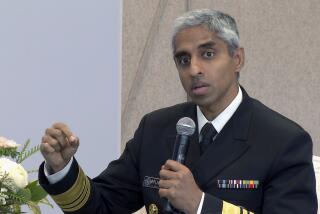Surgeon infected patients during heart procedure, Cedars-Sinai admits
A heart surgeon at Cedars-Sinai Medical Center unwittingly infected five patients during valve replacement surgeries earlier this year, causing four of the patients to need a second operation.
The infections occurred after tiny tears in the latex surgical gloves routinely worn by the doctor allowed bacteria from a skin inflammation on his hand to pass into the patients’ hearts, according to the hospital. The patients survived the second operation and are still recovering, hospital officials said.
The outbreak led to investigations by the hospital and both the L.A. County and California departments of public health. The federal Centers for Disease Control and Prevention was also consulted.
Hospital officials called it a “very unusual occurrence” probably caused by an unfortunate confluence of events: the nature of the surgery, the microscopic rips in the gloves and the surgeon’s skin condition. Valve replacement requires the surgeon to use thick sutures and tie more than 100 knots, which can cause extra stress on the gloves, they said.
Nevertheless, the hospital’s goal is to have zero infections, said Harry Sax, vice chairman of the hospital’s department of surgery. “Any hospital-acquired infection is unacceptable,” he said.
The infections raise questions about what health conditions should prevent a surgeon from operating and how to get the best protection from surgical gloves. Surgeons with open sores or known infections aren’t supposed to operate, but there is no national standard on what to do if they have skin inflammation, said Rekha Murthy, medical director of the hospital’s epidemiology department. She added that there were also no national standards on types of gloves used, whether to wear double gloves or how many times surgeons should change those gloves during a procedure.
Healthcare-acquired infections are very common throughout the United States. Each year, infections cause 99,000 deaths in the country, including about 12,000 in California. Hospitals in the state are required to report certain infections to the California Department of Public Health. That reporting makes the public more aware of the quality of care provided at local hospitals and is an important tool for reducing infections, said Debby Rogers, deputy director of the department’s Center for Health Care Quality.
Cedars-Sinai has low rates for hospital-acquired infections compared with the state and national average but has not performed as well on other surgical quality measures recently, according to the Leapfrog Group, an employer-backed nonprofit focused on healthcare quality. The organization gave the hospital a C rating last month on its national report card, down from an A in June, though it was not related to the infection outbreak.
“Clearly this hospital is making attempts to reduce infections, but they have more work to do,” said Leah Binder, Leapfrog’s chief executive.
Cedars-Sinai Medical Center conducts about 360 valve replacement surgeries each year and said infections occur in fewer than 1% of its cases — lower than the national average.
The hospital learned about the problem in June after three patients who had undergone valve replacement surgery showed signs of infection. Doctors diagnosed the patients with an infection called endocarditis. Concerned there might be a connection among the cases, epidemiologists analyzed the bacteria, staphylococcus epidermidis, and determined that it was an identical strain and therefore must have come from a single source. “It led to the question of gee, I wonder where it came from?” Murthy said.
Epidemiologists homed in on the surgeon with the skin inflammation. The bacteria matched, and then they made a surprising discovery: microscopic tears in the gloves typically worn by surgeons after performing valve replacement surgery. The surgeon, whose name was not released, was not allowed to operate again until he healed. He is still a member of the medical staff but no longer performs surgeries at the hospital.
The hospital soon found the same infection in two more patients. Officials also reached out to 67 patients who had heart valve replacements with the same surgeon but didn’t find any other cases. One of the five infected patients was treated with antibiotics, and the other four had new valve replacement surgeries. Sax said the hospital apologized to the patients and has continued to monitor their health. The hospital has also covered the cost of their care, including follow-up treatment and all the related surgeries.
All surgeons doing valve replacements are now required to change gloves more frequently, officials said. Some surgeons are wearing double gloves during the operations, Sax said.
Following the outbreak, Cedars-Sinai did the proper follow-up to ensure the safety of their patients, said Dawn Terashita, a medical epidemiologist with L.A. County, who was notified in September. What occurred at Cedars-Sinai was an unintentional consequence of the surgery, she said.
“There is no way to keep a room entirely sterile and all the people in it sterile,” she said. “You will always have risk of infection.”
More to Read
Sign up for Essential California
The most important California stories and recommendations in your inbox every morning.
You may occasionally receive promotional content from the Los Angeles Times.










